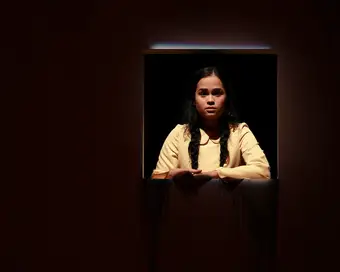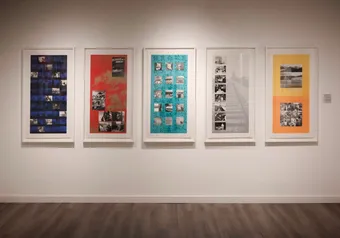While spending an evening dwelling on the themes of child murder, infidelity and domestic violence probably isn’t anyone’s idea of a light-hearted time, UBC Theatre encourages the audience to consider these difficult topics with their production of Lion in the Streets.
Set in 1990s Ontario, the play comprises eight vignettes where different characters are either experiencing or reliving intense moments of their life. What connects these seemingly unrelated scenes is the ghost of nine-year-old Isobel (Sophia Paskalidis), who wanders through her old town, searching for her murderer.
The capital “O” Other
Lion has no reservations about bringing marginalized characters to the forefront.
Playwright Judith Thompson designed a play where one of the very few creative liberties that could be taken was to ensure that the main character would be considered an ethnic minority. Although Isobel is Portuguese in the original script, director Michelle Thorne decided to change her ethnicity to Filipino in order to reflect Paskalidis’s heritage.
Thompson mentions in the preface of the play that Isobel can be portrayed as any ethnicity, as long as she is an other. “Capital ‘O’ other,” explained lighting director Rachel Shaen.
Lion places a strong emphasis on making the audience aware of this “otherness.” It expects viewers to leave having acknowledged and recognized the similarities between themselves and those seemingly obscured by this “otherness.” It brings to light marginalized groups whose issues are often overlooked and tries to evoke compassion.
“These stories need to be told because these are real people in our lives,” said Paskalidis, “whether we know it or not.”
“I really want the audience to understand that within this fantastical stylized abstract world, these are real people, real voices of real humans,” added Thorne.
The play also asks the audience to consider atrocities linked directly with Canada, instead of merely comparing themselves to the US and absolving themselves of guilt.
“It points a finger at Canadians who point fingers at Americans,” explained Shaen. “... The show is so distinctly Canadian.”
[Sorry, video not found. You can contact webmaster@ubyssey.ca to fix the issue]
Alternatively abled bodies on stage
“When I was originally doing my pre-production work throughout the summer months, I made a list for myself: ‘All the Things That I’m Afraid Of,’” said Thorne. “And the scene with Christine and Scarlett, who has cerebral palsy, was the number one scene that I was the most afraid of approaching.”
Due to regulations in the Department of Theatre and Film, Thorne was only allowed to cast UBC BFA acting students in their third or fourth year for this production, all of whom are able-bodied performers.
“I’m an able-bodied woman,” said Thorne, “and I don’t have a direct relationship or direct experience of what it’s like to inhabit an alternatively abled body such as the one that Scarlett lives in.”
To overcome this obstacle, Thorne reached out to Theatre Terrific, a local group that supports artists of all abilities in creating provocative theatre. She was put in touch with Leanne Crow and Willow Eady, who agreed to come on board as cultural consultants for the production.
“Every single time that we rehearsed the scene involving Scarlett and Christine, both of these women with cerebral palsy were a part of the rehearsal process,” said Thorne. “The vocal inflection that the actress Elizabeth Young — who is playing the character of Scarlett — employs are directly taken from Leanne Crow’s own voice and how cerebral palsy affects her voice.
“All of the choices that came to pass in that scene have been directly in conversation and consultation with those two women.”
Symbolism from script to stage
“[The title] refers specifically to this predator that’s roaming in the streets, Isobel’s murderer,” explained Thorne “but it also refers to the Lion that lives inside of all of us.”
And Lion’s symbolism extends past its title. The production also uses technical and creative elements which convey their own messages throughout the play.
The use of lighting is a large feature in the play, one that may often go unnoticed but enhances the themes and atmosphere.
“I’m trying to make the lighting design very beautiful, but very unsettling,” said Shaen.
Symbolism and the production’s goal of leaving the audience with a sense of relation went hand in hand. Light was used to create different colours and shadows with the intent of representing secrets and, as Shaen put it, “extreme moments of intensity.” This was in hopes the message could be conveyed that “every single person has a shadow just like these characters do.”
The costuming also proved to be a large element in creating a sense of familiarity between the characters and the audience. Costume designer Alice Jiang explained that she dressed characters with an emphasis on being relatable to the audience.
Even though the show is set in the 90s, the costumes were not made to look like the exaggerated fashion often depicted on screen, but a sincerer portrayal of the everyday individual living in that decade.
Lion plays with the idea of putting the audience at a place of privilege where they recognize the characters as “different people, but people that you’ve seen on the street probably every single day,” said Jiang.
[Sorry, video not found. You can contact webmaster@ubyssey.ca to fix the issue]
Creating a world where dangerous things can happen
The all-women production team of Lion in the Streets, unfortunately, doesn’t reflect the real world.
“I think it says something about the times that we get to do this,” said Shaen, “but it also is bad as well.… I think that’s extremely important to say — that once people leave school and try to go into the professional world, that’s when it stops. Especially in lighting design [and] … tech theatre.”
Thorne agreed, though she also mentioned that she’d only seen Lion produced once before — also by a woman. She wondered what it would be like to produce this play with a male director.
“Some of the darker events that happen in the play mostly happen to female characters. There are, of course, male characters that suffer abuse as well in the play. But I think having women supporting and caring for other women is a huge advantage.”
That emphasis on support and care for others has been Thorne’s priority throughout this production. For the actors and crew, the director implemented a self-care table with items that bring comfort — essential oils, adult colouring books and a Buddha. For the audience, it’s a little bit more difficult to develop this trust and communication.
“We’ve taken a lot of steps to make sure that the people involved in the production of the play are safe,” said Thorne. “We can’t do that with all 200 people who are going to be coming each night to the theatre.”
There will be trigger warnings on the doors of the theatre, and Thorne asserts that if an audience member has concerns, they are more than welcome to come find any member of the production team and have a conversation.
Despite this, Thorne hopes that the intensity of subject matter doesn’t stop people from coming to see the play.
“It’s okay if you don’t think that you’re going to be able to enjoy the play or get the message of the play because you are triggered by the material,” said Thorne. “... As important as I think it is for these trigger warnings to be there, I hope that they inspire people to reach into their own strength of their own character.”
The cast echoed these sentiments.
“[Michelle] was always repeating to us ‘We’re creating a safe space where dangerous things can happen, not a dangerous space where safe things can happen,’” said Paskalidis.
Lion in the Streets will be performed at the Telus Studio Theatre between January 16 to February 2. Student tickets are available online.
[Sorry, video not found. You can contact webmaster@ubyssey.ca to fix the issue]
First online
Share this article



![['auto']](https://storage.googleapis.com/ubyssey/media/renditions/lits_3.width-1000.format-webp.webp)
![['auto']](https://storage.googleapis.com/ubyssey/media/renditions/lits_2.width-1000.format-webp.webp)
![['auto']](https://storage.googleapis.com/ubyssey/media/renditions/lits_4.width-1000.format-webp.webp)
![['auto']](https://storage.googleapis.com/ubyssey/media/renditions/lits_1.width-1000.format-webp.webp)





